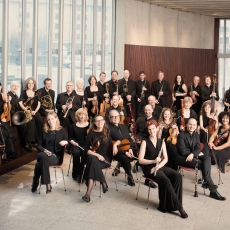Berlioz Symphonie Fantastique - SCO & Ticciati - NPR Deceptive Cadence
Robin Ticciati is the principal conductor of the Scottish Chamber Orchestra and principal guest conductor of the Bamberg Symphony in Germany. He's conducted at the Metropolitan Opera and just finished a run of Britten's Peter Grimes at La Scala. Ticciati has also been tapped to take over England's storied Glyndebourne Festival Opera in 2014. And did I mention he's under 30?
The career of the young British conductor, with his boyish looks and Dudamel-like mop of curly dark hair, has been rising with lightning speed. It wasn't that long ago Ticciati's talents were spotted (and later cultivated) by veteran conductors Simon Rattle and Colin Davis when he was a teenage timpanist in Britain's National Youth Orchestra. At age 21 he made his opera conducting debut in a Glyndebourne production of Mozart's Magic Flute.
Now, at the close of his third season leading the SCO, Ticciati and his players have released their first album together, a lithe and gripping account of one of the essential workouts for any orchestra, Hector Berlioz's Symphonie Fantastique.
Paris audiences in 1830 had never heard anything remotely like it. The nearly hour-long symphony is a shocking self-portrait in sound, documenting the composer's obsessive pursuit of Shakespearean actress Harriet Smithson. Berlioz used - some said abused - the symphony orchestra as an outlet for the feverish emotions of a man wildly in love. In Berlioz's hands, brasses snarl and woodwinds shriek like feral beasts.
With all the dramatic outpouring, it's easy, Ticciati says, for conductors and orchestras to get carried away. "I hear this piece as an opera," he told Gramophone recently. "It's incredibly vivid, but too many performances overdo it."
Ticciati is careful not to overplay or splash excessive color. Working with an orchestra smaller than the composer prescribed, he manages to tell Berlioz's fantastic story - from the ardent and lyrical to the horrifically grotesque - with detailed transparency and enough firepower for the big dramatic moments.
Ticciati's violins are light on their feet yet ache with yearning as the graceful main melody, depicting Berlioz's beloved, appears in the opening movement. Underneath, the low strings beat with the nervous palpitations of the young lover's heart. Moments for individual players also stand out for their color and polish, most notably the plaintive English horn solo that arches over the pastoral landscape in the Scene in the Fields.
This is an agile, feline Fantastique, especially in the final two movements - The "March to the Scaffold" and "Dream of a Witches' Sabbath" - where the macabre and melodramatic play out in musical hallucinations.
Thinking his love is unrequited, Berlioz poisons himself with opium which, instead of killing him, plunges him into a nightmare: He murders his beloved and is led to the scaffold for beheading. Ticciati builds the movement with suspense, from the eerie distant timpani and muted brass to swirling strings and snorting tubas. At the end, Smithson's memory, in a deranged little clarinet riff, flashes across the composer's mind just before the blade drops. Ticciati's brass and percussion deliver the swift blow and the head falls with a kerplunk and the crowd cheers in a brass fanfare. (Hear it near the end of the excerpt above.)
At his own funeral, Berlioz sees an orgy of witches and ghosts, and among them drifts Smithson herself. It's hard to imagine being an audience member in 1830, listening to Berlioz's bacchanal of otherworldly (and innovative) sounds, including squealing clarinets, the tolling of real bells and the skeletal tapping of violin strings with the wooden part of the bow.
It all sounds fresh and potent in Ticciati's hands, with the SCO players giving their all in the symphony and the sprightly overture from Béatrice and Bénédict that follows. Linn records, the audiophile label from Scotland, has captured the orchestra in lustrous sound. I suggest you turn this one up loud.


